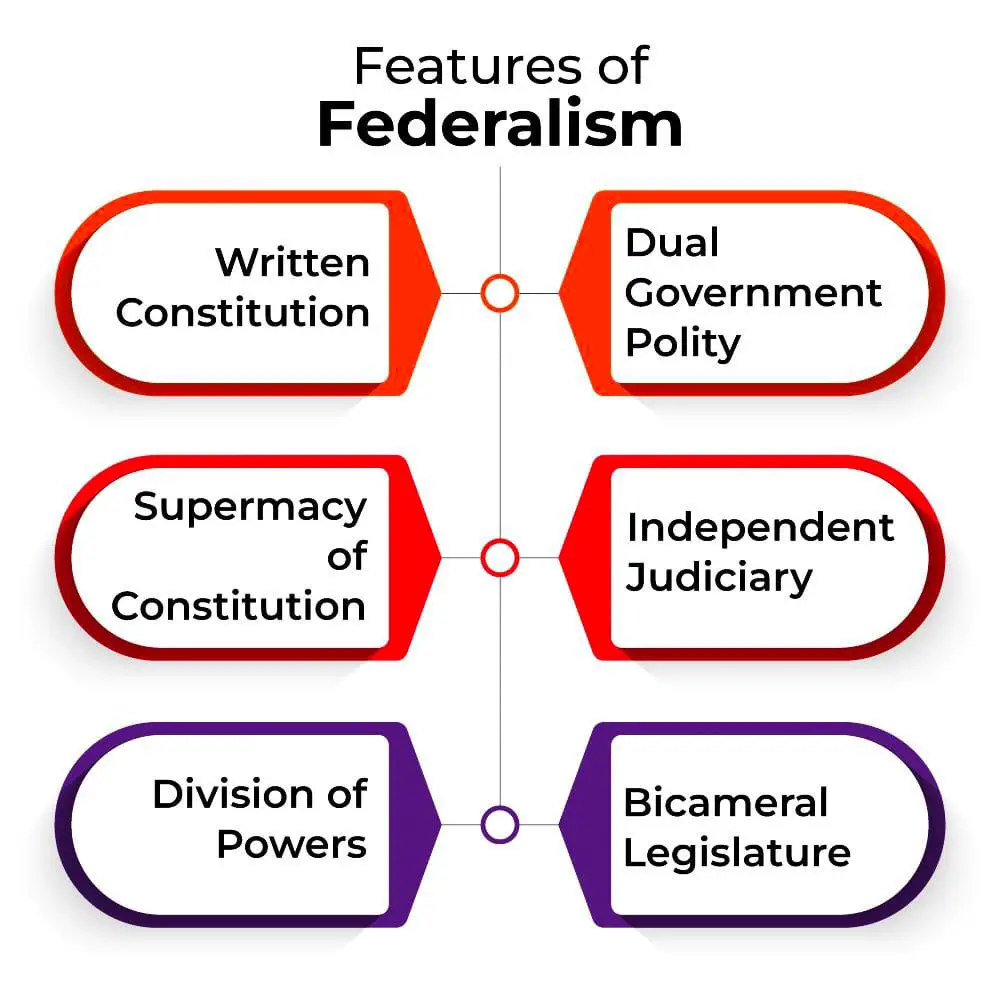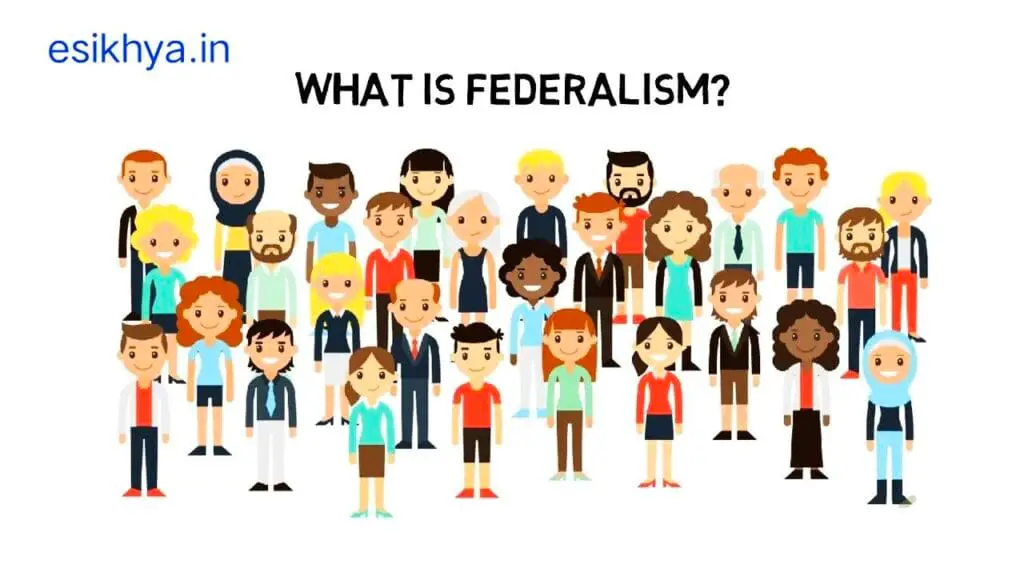Federalism : Meaning, Features, Type’s, Example’s, Advantages & Disadvantages
Federalism is a system of government in which powers and responsibilities are divided between a central (national) government and regional (state or provincial) governments. Both levels of government operate independently within their areas of authority, and each has its own set of powers that cannot be overruled by the other. The aim of federalism is to balance power to ensure a fair distribution of governance and to prevent any one entity from becoming too powerful.
In essence, federalism allows for unity while preserving diversity, as different regions within a country can have their own governments with policies tailored to their specific needs, while still being part of a larger nation.

Features of Federalism :
- Dual Government:
- In a federal system, there are two levels of government: a central (or federal) government and regional (state or provincial) governments. Each level governs its respective subjects under the Constitution. For example, in India, there is a central government and various state governments, each with distinct powers.
- Division of Powers:
- The powers and responsibilities are clearly divided between the central government and state governments. Typically, the division is outlined in a Constitution, with a specific list of subjects under the jurisdiction of each level of government. For instance:
- Union List: Subjects under the central government (e.g., defense, foreign policy).
- State List: Subjects under the state governments (e.g., police, healthcare).
- Concurrent List: Subjects where both levels can legislate (e.g., education, criminal law).
- The powers and responsibilities are clearly divided between the central government and state governments. Typically, the division is outlined in a Constitution, with a specific list of subjects under the jurisdiction of each level of government. For instance:
- Supremacy of the Constitution:
- The Constitution is the supreme law in a federal system. Any conflict between the central and state governments is resolved by the Constitution, which provides the framework for both levels of government to function. Changes to this structure often require constitutional amendments, which usually need approval from both levels of government.
- Rigid Constitution:
- Federal systems tend to have a rigid Constitution that cannot be easily amended by the central government alone. This ensures that the division of powers remains balanced and prevents arbitrary changes. Constitutional amendments typically require the consent of both the national and state governments.
- Independent Judiciary:
- A hallmark of federalism is the presence of an independent judiciary (usually a Supreme Court) that resolves disputes between the central and state governments. The judiciary ensures that neither the central nor the regional governments exceed their constitutional powers.
- Bicameral Legislature:
- Federal systems often have a bicameral (two-house) legislature at the central level. One house represents the national population (e.g., the House of Representatives in the U.S., the Lok Sabha in India), while the other represents the states or regions (e.g., the U.S. Senate, the Rajya Sabha in India). This ensures that states have a voice in central governance.
- Autonomy of Each Government:
- In a federal system, both the central and state governments are autonomous within their areas of jurisdiction. Each level of government operates independently, without interference from the other, within its constitutionally assigned powers.
- Financial Independence:
- Each level of government in a federal system has its own sources of revenue. While the central government may collect certain taxes, state governments also have taxation powers to fund their own activities. Often, there is a system of revenue sharing to ensure financial balance between richer and poorer regions.
- Cooperative Federalism:
- While the central and state governments have distinct powers, they must often cooperate to address national issues or shared responsibilities. For example, central and state governments may work together on matters of education, healthcare, and infrastructure. In India, this idea is often referred to as cooperative federalism.
- Checks and Balances:
- Federalism inherently provides a system of checks and balances by ensuring that no single level of government holds too much power. The autonomy of state governments serves as a check on the central government, and vice versa.

Types of Federalism :
- Dual Federalism:
- In dual federalism, the national and state governments operate independently in their own spheres of authority, with minimal interaction. Each level of government is sovereign in its own areas of responsibility.
- Cooperative Federalism:
- In cooperative federalism, the national and state governments work together on various issues and share responsibilities, often with overlapping powers. There is more collaboration between levels of government to solve complex national problems.
- Fiscal Federalism:
- This refers to the financial relationships between different levels of government, where central and state governments collaborate on revenue generation, allocation, and expenditure. Often, the central government provides grants to the states for specific purposes, which is common in countries like India and the United States.
- Asymmetrical Federalism:
- In some federal systems, certain states or regions may have more autonomy than others, based on specific historical, cultural, or political circumstances. This is known as asymmetrical federalism. For example, India grants special autonomy to states like Jammu and Kashmir (under Article 370), though this was abrogated in 2019, and Nagaland under Article 371A.
Examples of Federal Systems :
- United States: One of the earliest modern federal systems, where power is divided between the national government and the 50 individual states.
- India: A quasi-federal system, where the Constitution outlines a detailed division of powers between the central government and state governments.
- Australia: Another example of federalism, where the Constitution divides powers between the national government (Commonwealth) and the states.
- Germany: A federal republic with power shared between the national government and 16 federal states (Länder).
Advantages of Federalism :
- Promotes Local Autonomy:
- Federalism allows regions or states to govern themselves, making laws and policies suited to their unique needs and conditions.
- Prevents Concentration of Power:
- By distributing power across multiple levels of government, federalism helps prevent the rise of an overly powerful central government, protecting democracy and individual freedoms.
- Encourages Innovation and Experimentation:
- State or regional governments can experiment with policies, which, if successful, can be adopted by other regions or the national government. This allows for innovation in governance.
- Accommodates Diversity:
- Federalism allows for a degree of local control, which can be particularly important in countries with diverse populations, cultures, and languages, like India.
- Improved Governance:
- Decentralization of power often leads to more efficient governance because local governments are more aware of the specific needs of their people and can respond more quickly to local issues.
Disadvantages of Federalism :
- Possibility of Conflict:
- Federalism can lead to conflicts between central and state governments, especially in cases where their jurisdictions overlap or where there is disagreement over policies.
- Uneven Development:
- Different states or regions may develop at different rates, leading to regional disparities. Wealthier states may be able to offer better services, while poorer regions might lag behind.
- Duplication of Government:
- Having multiple levels of government can result in duplication of efforts and bureaucracy, which may lead to inefficiency.
- Complexity:
- The division of power between national and regional governments can make governance complex, especially when responsibilities overlap.
Conclusion:
Federalism is a system designed to divide power, promote local governance, and protect diversity within a unified country. While it has clear advantages, such as fostering autonomy and preventing the concentration of power, it also presents challenges like potential conflicts and uneven development. Despite these challenges, federalism has been a successful governance model in many countries, ensuring both unity and diversity.
Share this content:


Leave a Reply